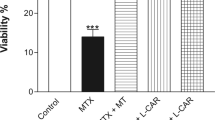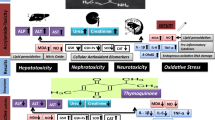Abstract
δ-aminolevulinic acid (ALA), a heme precursor which accumulates during lead poisoning and acute intermittent porphyria, is reported to cause liver cancer. The carcinogenic mechanisms of ALA may relate to its ability to generate free radicals through metal-catalyzed oxidation which cause oxidative DNA damage. The aim of this study was to compare the efficacy of melatonin, trolox (vitamin E) and mannitol in altering DNA damage induced by ALA. Herein, we found, in the presence of Fe2+, that ALA-induced formation of 8-hydroxydeoxyguanosine in calf thymus DNA was dose and time-dependent. Melatonin, mannitol and trolox, all of which are free radical scavengers, inhibited the formation of 8-hydroxydeoxyguanosine in a concentration-dependent manner. The concentration of each (melatonin, mannitol and trolox) required to reduce DNA damage by 50%, i.e., the IC50, was 0.52, 0.84 and 0.90 mM, respectively.
Similar content being viewed by others
References
Battle AM: Porphyrins, porphyrias, cancer and photodynamic therapy - a model for carcinogenesis. J Photochem Photobiol B Biol 20: 5-22, 1993
de Verneuil H, Ged C, Boulechfar S, Moreau-Gaudry F: Porphyrias: Animal models and prospects for cellular and gene therapy. J Bioenerg Biomembr 27: 239–248, 1995
Monteiro HP, Bechara EJ, Abdalla DS: Free radical involvement in neurological porphyrias and lead poisoning. Mol Cell Biochem 103: 73–83, 1991
Lithner F, Wetterberg L: Hepatocellular carcinoma in patients with acute intermittent porphyria. Acta Med Scand 215: 271–274, 1984
Gubler JG, Bargetzi MJ, Meyer UA: Primary liver carcinoma in two sisters with acute intermittent porphyria. Am J Med 89: 540–541, 1990
Kauppinen R, Mustajoki P: Acute hepatic porphyria and hepatocellular carcinoma. Br J Cancer 57: 117–120, 1988
Fraga CG, Onuki J, Lucesoli F, Bechara EJ, Di Mascio P: 5-Aminolevulinic acid mediates the in vivo and in vitro formation of 8-hydroxy-2′-deoxyguanosine in DNA. Carcinogenesis 15: 2241–2244, 1994
Douki T, Onuki J, Medeiros MH, Bechara EJ, Cadet J, Di Mascio P. Hydroxyl radicals are involved in the oxidation of isolated and cellular DNA bases by 5-aminolevulinic acid. FEBS Lett 428: 93–96, 1998
Shibutani S, Takeshita M, Grollman AP: Insertion of specific bases during DNA synthesis past the oxidation-damaged base 8-oxodG. Nature 349: 431–434, 1991
Cheng KC, Cahill DS, Kasai H, Nishimura S, Loeb LA: 8-Hydroxyguanine, an abundant form of oxidative DNA damage, causes G - T and A - C substitutions. J Biol Chem 267:166–172, 1992
Reiter RJ, Melchiorri D, Sewerynek E, Poeggeler B, Barlow-Walden L, Chuang J, Ortiz GG, Acuna-Castroviejo D: A review of the evidence supporting melatonin's role as an antioxidant. J Pineal Res 18: 1–11, 1995
Reiter RJ, Tan DX, Kim SJ, Qi W: Melatonin as a pharmacological agent against oxidative damage to lipids and DNA. Proc West Pharmacol Soc 41: 229–236, 1998
Tan D-X, Chen L-D, Poeggeler B, Manchester LJ, Reiter RJ: Melatonin: A potent endogenous hydroxyl radical scavenger. Endocrine J 1: 57–60, 1993
Matuszak Z, Reszka K, Chignell CF: Reaction of melatonin and related indoles with hydroxyl radicals: EPR and spin trapping investigations: Free Radic Biol Med 23: 367–372, 1997
Stasica P, Ulanski P, Rosiak JM: Melatonin as a hydroxyl radical scavenger. J Pineal Res 25: 65–66, 1998
Noda Y, Mori A, Liburdy R, Packer L: Melatonin and its precursors scavenge nitric oxide. J Pineal Res 27: 159–163, 1999
Cagnoli CM, Atabay C, Kharlamova E, Manev H: Melatonin protects neurons from singlet oxygen-induced apoptosis. J Pineal Res 18: 222-226, 1995
King M, Scaiano JC: The excited states of melatonin. Photochem Photobiol 65: 538–542, 1995
Gilad E, Cuzzocrea S, Zingarelli B, Salzman AL, Szabo C: Melatonin is a scavenger of peroxynitrite. Life Sci 60: PL 169–174, 1997
Cuzzocrea S, Zingarelli B, Gilad E, Hake P, Salzman AL, Szabo C: Protective effect of melatonin in carrageenan-induced models of local inflammation: relationship to its inhibitory effect on nitric oxide production and its peroxynitrite scavenging activity. J Pineal Res 23: 106-116, 1997
Costa EJ, Lopes RH, Lamy-Freund MT: Permeability of pure lipid bilayers to melatonin. J Pineal Res 19: 123–126, 1995
Shida CS, Castrucci AM, Lamy-Freund MT. High melatonin solubility in aqueous medium. J Pineal Res 16: 198–201, 1994
Menendez-Pelaez A, Poeggeler B, Reiter RJ, Barlow-Walden L, Pablos MI, Tan DX: Nuclear localization of melatonin in different mammalian tissues: immunocytochemical and radioimmunoassay evidence. J Cell Biochem 53: 373–382, 1993
Tan D, Reiter RJ, Chen LD, Poeggeler B, Manchester LC, Barlow Walden LR: Both physiological and pharmacological levels of melatonin reduce DNA adduct formation induced by the carcinogen safrole. Carcinogenesis 15: 215–218, 1994
Qi W, Reiter RJ, Tan DX, Manchester LC, Siu AS, Garcia JJ: Increased levels of oxidatively damage DNA induced by chromium(III) and H2O2: Protection by melatonin and related indoles. J Pineal Res 29: 54–61, 2000
Qi W, Reiter RJ, Tan DX, Garcia JJ, Manchester LC, Karbownik M, Calvo JR: Chromium(III)-induced 8-hydroxydeoxyguanosine in DNA and its reduction by antioxidants: Comparative effects of melatonin, ascorbate and vitamin E. Environ Health Perspect 108: 399–402, 2000
Tang L, Reiter RJ, Li ZR, Ortiz GG, Yu BP, Garcia JJ: Melatonin reduces the increase in 8-hydroxy-deoxyguanosine levels in the brain and liver of kainic acid-treated rats. Mol Cell Biochem 178: 299–303, 1998
Sewerynek E, Ortiz GG, Reiter RJ, Pablos MI, Melchiorri D, Daniels WM: Lipopolysaccharide-induced DNA damage is greatly reduced in rats treated with the pineal hormone melatonin. Mol Cell Endocrinol 117: 183–188, 1996
Qi W, Reiter RJ, Tan DX, Manchester LC, Kim SJ, Garcia JJ: Inhibitory effects of melatonin on ferric nitrilotriacetate-induced lipid peroxidation and oxidative DNA damage in the rat kidney. Toxicology 139: 81–91, 1999
Vijayalaxmi, Meltz ML, Reiter RJ, Herman TS: Melatonin and protection from genetic damage in blood and bone marrow: Whole-body irradiation studies in mice. J Pineal Res 27: 221–225, 1999
Wakatsuki A, Okatani Y, Izumiya C, Ikenoue N: Melatonin protects against ischemia and reperfusion-induced oxidative lipid and DNA damage in fetal rat brain. J Pineal Res 26: 147–152, 1999
Onuki J, Medeiros MH, Bechara EJ, Di Mascio P: 5-Aminolevulinic acid induces single-strand breaks in plasmid pBR322 DNA in the presence of Fe2+ ions. Biochim Biophys Acta 1225: 259–263, 1994
Li XJ, Zhang LM, Gu J, Zhang AZ, Sun FY: Melatonin decreases production of hydroxyl radical during cerebral ischemia-reperfusion. Acta Pharmacol Sinica 18: 394–396, 1997
Stasica P, Ulanski P, Rosiak JM: Melatonin as a hydroxyl radical scavenger. J Pineal Res 25: 65–66, 1998
Tan DX, Manchester LC, Reiter RJ, Plummer BF, Hardies LJ, Weintraub ST, Vijayalaxmi, Shepherd AM: A novel melatonin metabolite, cyclic 3-hydroxymelatonin: A biomarker of in vivo hydroxyl radical generation. Biochem Biophys Res Commun 253: 614–620, 1998
Zang LY, Cosma G, Gardner H, Vallyathan V: Scavenging of reactive oxygen species by melatonin. Biochem Biophys Acta 1425: 469–477, 1998
Reiter RJ: Oxidative damage in the central nervous system: Protection by melatonin. Prog Neurobiol 56: 359–384, 1998
Limson J, Nyokong T, Daya S: The interaction of melatonin and its precursors with aluminium, cadmium, copper, iron, lead, and zinc: An adsorptive voltammetric study. J Pineal Res 24: 15–21, 1998
Ohta Y, Kongo M, Sasaki E, Nishida K, Ishiguro I: Therapeutic effect of melatonin on carbon tetrachloride-induced acute liver injury in rats. J Pineal Res 28: 119–126, 2000
Ohta Y, Kongo M, Sasaki E, Ishiguro I, Harada N: Protective effect of melatonin against a-maphthylisoyanate-induced liver injury in rats. J Pineal Res 29: 15–23, 2000
El-Sokkary GH, Reiter RJ, Cuzzocrea S, Caputi AP, Hassanein AF, Tan DX: Role of melatonin in reduction of lipid peroxidation and peroxynitrite formation in non-septic shock induced by zymosan. Shock 12: 402–408, 1999
Reiter RJ, Tan DX, Qi W, Manchester, LC, Karbownik M, Calvo JR: Pharmacology and physiology of melatonin in the reduction of oxidative stress in vivo. Biol Signal Recep 9: 160–170, 2000
Carneiro RC, Reiter RJ. d-aminolevulinic acid-induced lipid peroxidation in rat kidney and liver is attenuated by melatonin: An in vivo and in vitro study. J Pineal Res 24: 131–136, 1998
Carneiro RC, Reiter RJ: Melatonin protects against lipid peroxidation induced by δ-aminolevulinic acid in tar cerebellum, cortex and hippocampus. Neuroscience 82: 293–299, 1998
Princ FG, Maxit AG, Cardalda C, Batlle A, Juknat AA: In vivo protection by melatonin against δ-aminolevulinic acid-induced oxidative damage and its antioxidative effect on the activity of haem enzymes. J Pineal Res 24: 1–8, 1998
Author information
Authors and Affiliations
Corresponding author
Rights and permissions
About this article
Cite this article
Qi, W., Reiter, R.J., Tan, DX. et al. Melatonin prevents δ-aminolevulinic acid-induced oxidative DNA damage in the presence of Fe2+. Mol Cell Biochem 218, 87–92 (2001). https://doi.org/10.1023/A:1007225809674
Issue Date:
DOI: https://doi.org/10.1023/A:1007225809674




